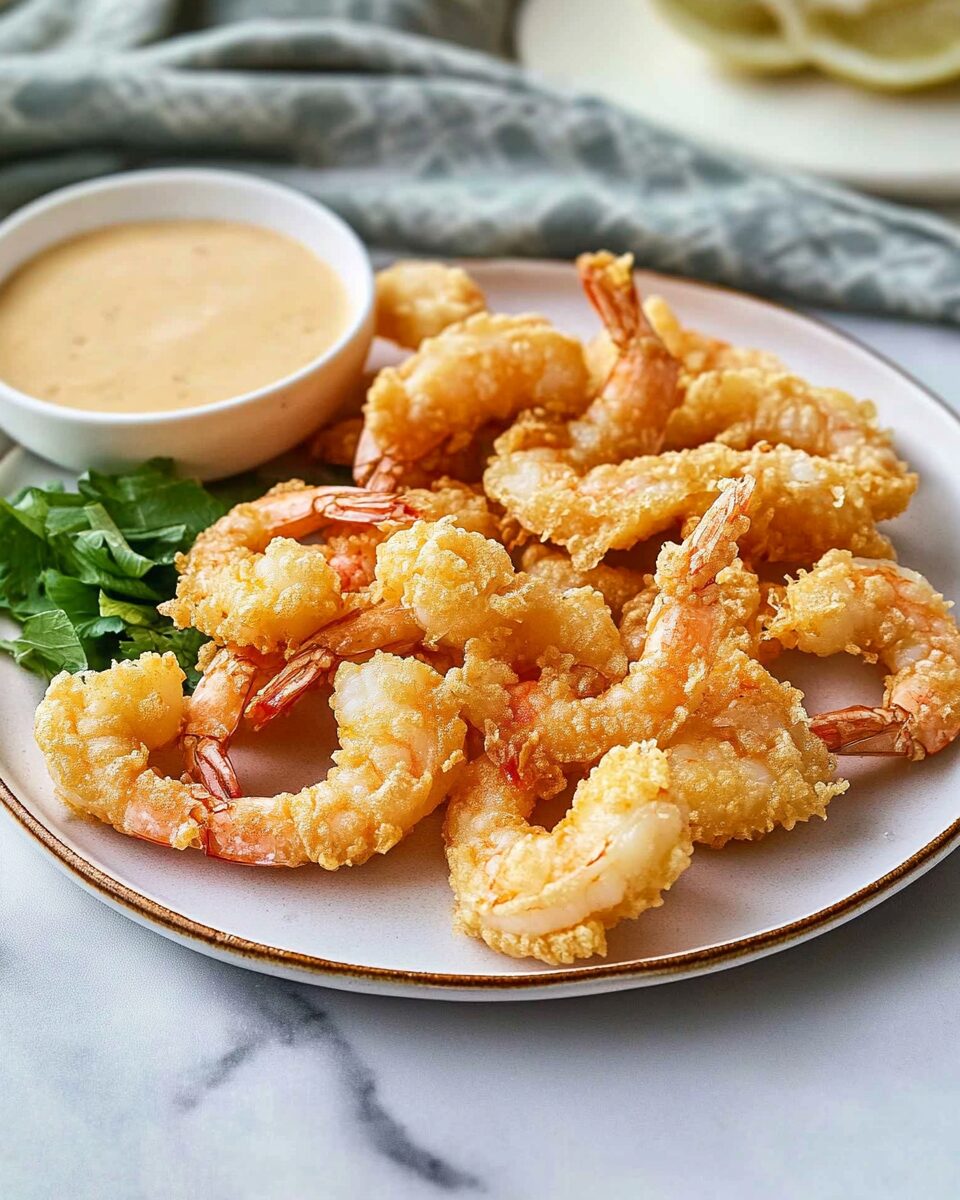Crispy Shrimp Tempura is a delightful Japanese dish featuring large shrimp coated in a light, airy batter and fried to golden perfection. The contrast between the succulent shrimp and the crispy exterior makes it a favorite among many. This recipe is perfect for gatherings, offering a restaurant-quality experience right at home.
FULL RECIPE:
Ingredients:
- 1 lb large shrimp, peeled and deveined
- 1 cup all-purpose flour
- 1/2 cup cornstarch
- 1 cup ice-cold water
- 1/2 tsp baking powder
- Oil for frying (vegetable or canola)
- Salt (to taste)
- Soy sauce (for serving)
- Lemon wedges (for serving)
Directions:
- Prepare the Shrimp: Pat dry the peeled and deveined shrimp using paper towels to remove excess moisture.
- Make the Tempura Batter: In a large bowl, whisk together the all-purpose flour, cornstarch, baking powder, and a pinch of salt. Gradually stir in the ice-cold water until just combined; it’s okay if the batter is slightly lumpy.
- Heat the Oil: In a deep pan or pot, heat about 2 inches of oil to 350°F (175°C). Using a thermometer can help maintain the correct temperature.
- Fry the Shrimp: Dip each shrimp into the tempura batter, allowing excess to drip off. Carefully place the shrimp into the hot oil, ensuring not to overcrowd the pan. Fry until golden and crispy, approximately 2-3 minutes, flipping halfway through for even cooking.
- Drain and Serve: Remove the shrimp from the oil with a slotted spoon and drain on paper towels. Serve immediately with soy sauce for dipping and lemon wedges on the side.
Nutritional Information:
- Serving Size: 1/4 of the recipe
- Calories: Approximately 350
- Protein: 25g
- Carbohydrates: 30g
- Fat: 15g
- Saturated Fat: 2g
- Cholesterol: 220mg
- Sodium: 800mg
- Fiber: 1g
- Sugar: 0g
The History of Tempura
Tempura has a rich history that dates back to the 16th century when Portuguese missionaries and traders introduced the technique of deep frying in batter to Japan. The word “tempura” is believed to have originated from the Latin word “tempora,” referring to times of fasting when Catholics abstained from eating meat and instead consumed fish and vegetables. The Japanese adapted this technique, creating their unique version with a lighter, crispier batter. Over time, tempura evolved into a staple of Japanese cuisine, with specialized tempura restaurants, known as “tempura-ya,” emerging throughout the country. Today, tempura is enjoyed worldwide, with variations that incorporate different types of seafood, vegetables, and even innovative fusion ingredients.
What Makes Shrimp Tempura Special?
Shrimp tempura stands out due to its delicate, crispy coating that contrasts beautifully with the tender, juicy shrimp inside. The key to achieving this texture lies in the batter, which is made from a simple combination of flour, cornstarch, baking powder, and ice-cold water. The cold temperature of the batter helps prevent gluten development, resulting in a light and airy crust. Another distinguishing feature of shrimp tempura is the preparation of the shrimp. To prevent curling during frying, small incisions are made along the underside of the shrimp. This technique allows the shrimp to remain straight, enhancing both its appearance and texture.
Serving Suggestions
Crispy Shrimp Tempura can be served in various ways to suit different preferences and occasions. It is often accompanied by a dipping sauce called “tentsuyu,” made from dashi, soy sauce, and mirin. A sprinkle of grated daikon radish adds a refreshing contrast to the savory flavors. For a more substantial meal, shrimp tempura can be served over a bed of steamed rice, known as “tendon,” or paired with soba or udon noodles in a dish called “tempura soba” or “tempura udon.” Garnishing with fresh lemon wedges and a sprinkle of sea salt can enhance the natural flavors of the shrimp.
Tips for Perfect Shrimp Tempura
- Use Ice-Cold Water: The batter should be kept as cold as possible to create a light, crispy texture. Some chefs even add ice cubes to the batter to maintain its chill.
- Do Not Overmix the Batter: A few lumps are okay. Overmixing can lead to gluten development, resulting in a denser, less crispy coating.
- Maintain the Right Oil Temperature: The ideal frying temperature is around 350°F (175°C). Too hot, and the batter will burn before the shrimp cooks through; too cool, and the tempura will absorb too much oil, becoming greasy.
- Fry in Small Batches: This helps maintain the oil temperature and ensures even cooking.
- Drain Properly: After frying, place the shrimp on a wire rack or paper towels to drain excess oil, keeping the tempura crisp.
Health Considerations
While tempura is deep-fried, it can still be part of a balanced diet when consumed in moderation. Using fresh ingredients and maintaining proper frying techniques can minimize oil absorption, making it a lighter option compared to other fried foods. Additionally, shrimp is a good source of protein, vitamins, and minerals, including selenium, vitamin B12, and phosphorus. For a healthier version, consider using heart-healthy oils like canola or grapeseed and pairing the tempura with fresh vegetables or a light salad. Some variations also incorporate whole grain flours or gluten-free alternatives for those with dietary restrictions.
Cultural Significance
In Japan, tempura is not just a dish; it’s a cultural experience. High-end tempura restaurants often feature chefs who specialize solely in the art of tempura, meticulously preparing each piece to perfection. Watching a tempura chef at work is like observing a culinary performance, with precise movements and attention to detail that reflect years of training and dedication. Tempura is also commonly enjoyed during Japanese festivals and special occasions. Its light, festive nature makes it a popular choice for celebratory meals, symbolizing prosperity and happiness.
Global Influence and Variations
The global popularity of tempura has led to numerous creative variations beyond the traditional Japanese style. In the United States and other countries, tempura is often incorporated into sushi rolls, adding a delightful crunch to maki or hand rolls. Fusion cuisine has also embraced tempura, with chefs experimenting by battering and frying a wide range of ingredients, from avocados and sweet potatoes to even ice cream. These innovative twists showcase the versatility of the tempura technique while introducing new flavor profiles and textures.
Conclusion
Crispy Shrimp Tempura is a timeless dish that embodies the elegance and simplicity of Japanese cuisine. Its light, crunchy batter and succulent shrimp make it a favorite for many, whether enjoyed as an appetizer, a main course, or part of a larger meal. Understanding the history, preparation techniques, and cultural significance of tempura adds depth to the appreciation of this delightful dish.






